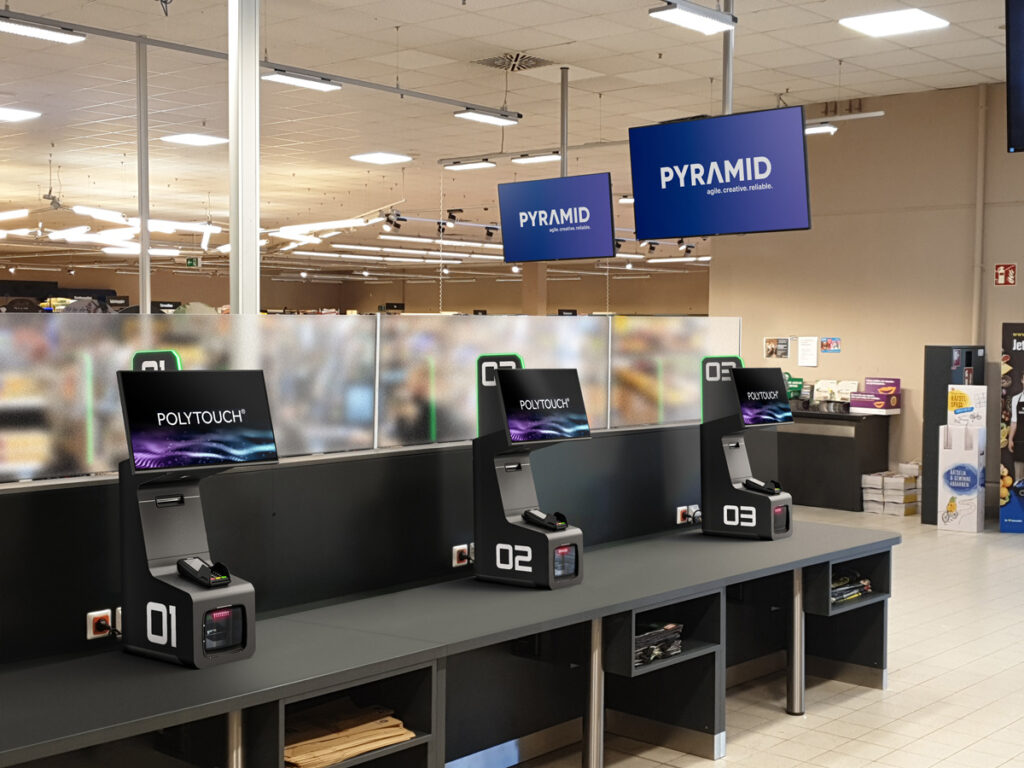
Pyramid Computer has received the Good Design Award for its new Polytouch® NANO self-checkout terminal. The GDA has been awarded by the Chicago Athenaeum since 1950 and is one of the most prestigious awards for industrial and product design. To be eligible for one of the coveted trophies, a product must deliver world-class innovation, concept, design, function, utility, material, form and aesthetic appeal. We succeeded in this with the NANO, and the enthusiasm was correspondingly great when the news arrived from Chicago, just in time for Christmas. For the competition of the year 2021, several thousand participants from over 55 countries submitted their designs – and Pyramid is one of the prize winners with the NANO!
The NANO is the successor to a terminal that we created exclusively for the assortment and store concept of the food retailer Edeka. The interest that the Edeka solution generated in the retail industry was the signal for us to develop the next generation of kiosks for the SCO. Although the NANO contains all the benefits of the Edeka terminal, it is much more than just an update.
The first challenge for our design team in making the NANO was to transfer the advantages of the highly specialized Edeka terminal into a solution that already covers the typical use cases of self-checkout for several retail segments in the basic configuration. In addition, the new terminal had to be easily adaptable to special application scenarios. And indeed, the NANO performs just as well at self-checkout in food retailing as it does in DIY stores or furniture stores. Its mix’n’match concept gives operators the option of cost-effective conversion and retrofitting of the mounting system and peripheral modules if their floor layout, product range, or payment offerings change. The NANO is thus the successful further development of a closed system that precisely meets a requirement profile into an open system that can be used in various retail segments for self-checkout.

The second challenge for the NANO arose from our requirement to develop a terminal for both the self-checkout of the present and the future. Existing technologies are changing at breathtaking speed and new ones are emerging at ever shorter intervals. Therefore, a SCO terminal of today has to be prepared for the technologies of tomorrow. Future-proofing is an advantage for operators andconsumers. Operators can expect a higher return on investment and consumers benefit because they can enjoy future developments without having to say goodbye to the terminal they are familiar with and switch to another: The LED light that guides self-checkout at NANO today may, in an already very near future, be swapped for an image sensor that takes high-resolution pictures of items for a machine-vision solution in the back office. An AI-powered process will recognize the items in a fraction of a second, without the customer having to spend any more time searching for and scanning the barcodes on the packaging, or even manually recording the name or code number of the item.
Against this background, the NANO, with its openness to developments of the next generation and the one after that, is also a successful example in terms of future-proofing. The technological future-proofing of the NANO is made clear in the futuristic look, which can already be found in the mood boards, where the terminal is still reminiscent of a spaceship.

The third challenge we gave our design team concerned the appearance of the new terminal: Like all Polytouch® kiosk solutions, it should catch the consumer’s attention on the surface and invite him to self-service. Nothing about it should give the impression that self-checkout could be cumbersome, complicated or time-consuming. The declared aim was to use the visual design of the NANO to dispel any reservations against self-service and to present it to customers as the best solution for payment. To solve this task, the design team gave the Nano a clear design language through chamfering. The arrangement of all components and peripheral modules in a vertical line also contributes to this. Both visual features give the terminal a sublime aura that makes it a landmark visible from afar in the colorful and small-scale item world of retail. The vertical line of peripheral modules from the scanner at the base to the printer below the screen corresponds to the checkout sequence and guides the customer through the process in a virtually self-explanatory manner. That’s why the SCO with the NANO is allowed to say: Scan! Pay! Be thrilled!
The award-winning NANO was created entirely in-house at the Pyramid Design Studio, which, together with the Innovation Hub, forms the company’s own development center for new technologies, designs and products. In just four months, a production-ready terminal was created whose technical and visual layout combine in an almost ideal way to create one of the most advanced self-checkout solutions on the market.
The Good Design Award is the second major international award Pyramid has won for its kiosk terminals in just 2 years. In 2020, the POLYTOUCH® FLEX received the European Design Award. Both honors show that we are way ahead in product design and play in the top league worldwide. In a few days, a NANO will make the journey to Chicago to present itself to visitors from all over the world at the Museum Of Architecture and Design. The Nano will also be featured in the illustrated book (Good Design Yearbook) that the museum is publishing about the 2021 award winners. Thanks to Jan Altes (product management), Tobias Bandel (product design), Peter Engler (CAD design) and Anthony Hunkler (product design) for your great teamwork!







